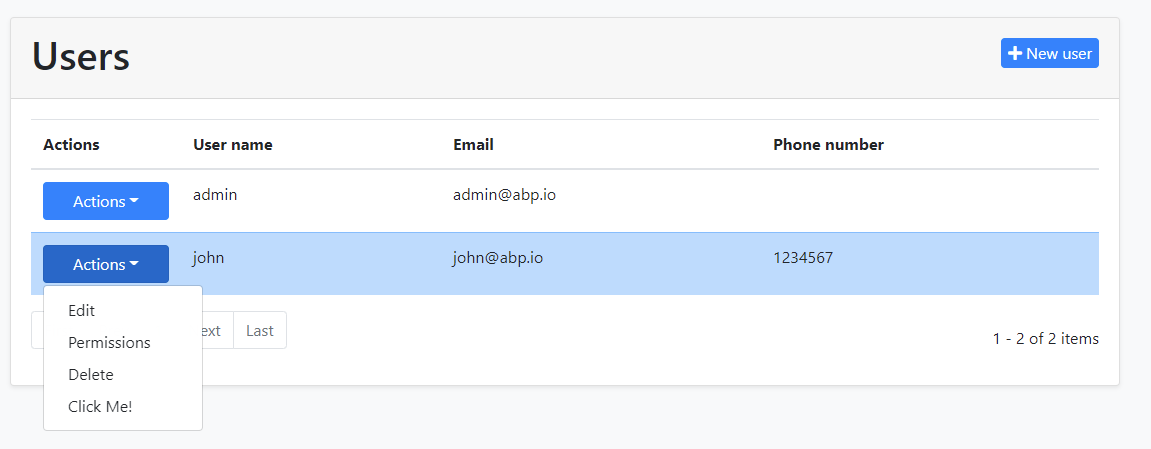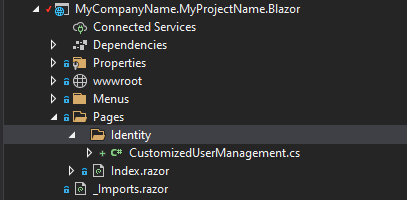Entity Action Extensions for Blazor UI
Entity action extension system allows you to add a new action to the action menu for an entity. A Click Me action was added to the User Management page below:
You can take any action (open a modal, make an HTTP API call, redirect to another page... etc) by writing your custom code. You can access to the current entity in your code.
How to Set Up
In this example, we will add a "Click Me!" action and execute a C# code for the user management page of the Identity Module.
Create a C# File
First, add a new C# file to your solution. We added inside the /Pages/Identity/ folder of the .Blazor project:
We will use the component override system in the Blazor. After creating a class inherits from the UserManagement component, we will override the SetEntityActionsAsync method and add the entity action programmatically.
Here, the content of the overridden SetEntityActionsAsync method.
protected override async ValueTask SetEntityActionsAsync()
{
await base.SetEntityActionsAsync();
var clickMeAction = new EntityAction()
{
Text = "Click Me!",
Clicked = (data) =>
{
//TODO: Write your custom code
return Task.CompletedTask;
}
};
EntityActions.Get<UserManagement>().Add(clickMeAction);
}
In the Clicked property, you can do anything you need.
Here, the entire content of the file.
using System.Threading.Tasks;
using Volo.Abp.AspNetCore.Components.Web.Extensibility.EntityActions;
using Volo.Abp.DependencyInjection;
using Volo.Abp.Identity.Blazor.Pages.Identity;
namespace MyCompanyName.MyProjectName.Blazor.Pages.Identity
{
[ExposeServices(typeof(UserManagement))]
[Dependency(ReplaceServices = true)]
public class CustomizedUserManagement : UserManagement
{
protected override async ValueTask SetEntityActionsAsync()
{
await base.SetEntityActionsAsync();
var clickMeAction = new EntityAction()
{
Text = "Click Me!",
Clicked = (data) =>
{
//TODO: Write your custom code
return Task.CompletedTask;
}
};
EntityActions.Get<UserManagement>().Add(clickMeAction);
}
}
}
Customizing Entity Actions
This section explains how to customize entity actions using the properties in the EntityAction type.
Here, the list of the properties that you use in the EntityAction.
Text: Entity action text.Clicked: Click event handler for the action. You can use thedataparameter to access the selected item in theDataGrid.Icon: Icon for the action.Color: Color for the action.Visible: Visible function to determine the actions' visibility based on the data grid items individually. You can make the action invisible for some data grid items. You can also use thedataparameter to access the selected item in theDataGrid.Confirmation: Confirmation message for the action. You can use thedataparameter to access the selected item in theDataGrid.
Example
var clickMeAction = new EntityAction()
{
Text = "Click Me!",
Clicked = (data) =>
{
//TODO: Write your custom code
return Task.CompletedTask;
},
Color = Blazorise.Color.Danger,
Icon = "fas fa-hand-point-right",
ConfirmationMessage = (data) => "Are you sure you want to click to the action?",
Visible = (data) =>
{
//TODO: Write your custom visibility action
//var selectedUser = data.As<IdentityUserDto>();
}
};


